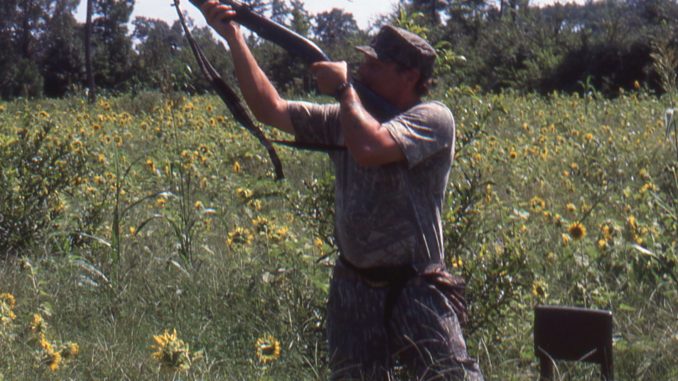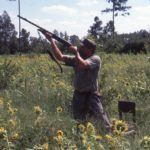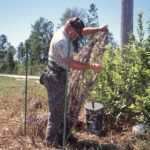
Take these tips and you’ll put more doves in your bag on Labor Day weekend.
The better part of three decades ago a longtime friend described anticipation of the opening of dove season, along with a joyful gathering when that glad day finally arrives, as “Christmas in September.”
His description is a singularly apt one, for a properly organized dove shoot involves camaraderie aplenty, festive dining reminiscent of the culinary wonders of Yuletide or perhaps a family reunion, maybe popcorn-popper action if the grey-winged speedsters are present in good numbers, and an overall holiday like sense of good feeling. The smell of burnt gunpowder drifting across the sere fields of September is a heady aroma for the hunter, telling him that the rites of autumn are once more at hand.
Participation in those rites brings a full measure of pleasure under most any circumstances other than a pronounced dearth of birds, but when doves are present, there are several things the savvy hunter can do — both before opening day and once afield — to improve his experience. A quick look at some proven pointers should make your outings more meaningful and productive.
A number of steps need to be taken before that magical moment, the first minute of legal shooting on opening day, finally arrives.
A few sessions of shooting clay targets won’t necessarily guarantee striking success in the dove field, but if nothing else, it will knock a bit of rust off, so to speak, and get you in the mood.
Provided you have access and know the precise field where you will be hunting, some scouting could also be in order. Look for any wires loaded with birds, dead trees at field’s edge where birds like to light before floating in to feed, and what seem to be favored flight paths. All will help you to choose a spot, and even if there is a draw for places or assigned stands, you’ll have a better feel for the doves’ preferred flight patterns.
Other things you need to keep in mind are making sure your gun is plugged, that you are well stocked with shells, and that you possess a current hunting license and HIP card. All these preparations may seem obvious and/or unnecessary, but one slip-up has the potential to spoil a hunt, while getting prepared should be viewed as an enjoyable part of the overall process.
Once the glad day arrives, there are more basic preparatory steps to be kept in mind. Make sure you have appropriate clothing. Lightweight camo is normally the way to go early in the season, although any type of comfortable attire in earth tones will work just fine. Carry plenty of moisture — including some for a dog if one accompanies you afield. Staying well hydrated in what is often withering early season heat is basic health common sense. Although not essential from a comfort standpoint, some type of stool can come in mighty handy when things are slow, as is often the case for the first couple of hours of an afternoon hunt. It also is an ideal place to store ammo, water, downed doves —carry a plastic grocery bag to put them in — insect repellent and other accessories.
Once at your stand, try to get as comfortable as possible. Some shade is always nice, as is a position where you don’t have to look into the sun. If you want to make a bit of a blind or even carry one made of camo cloth that can be quickly erected, that’s fine, although the real key is to avoid movement until doves are in range.
Among the hallmarks of veterans dove hunters are constant alertness, the patience to remain still until the bird presents itself in range, and recognition of the directions in which the most birds seems to be flying. You can’t cover 360 degrees no matter what your situation, and if you have woods as a backdrop, doves coming from behind you are a major problem for even the finest wingshooters with quick reflexes.
By the same token, a telltale sign of an inexperienced hand is taking impossibly long shots and spooking birds with movement before they are in range. Once a bird is within 40 yards, a reasonable maximum distance, you have ample time to mount the gun, get on the dove, and pull the trigger.
Shooting, even within reasonable range, is one thing; hitting what are sometimes devilishly difficult targets is quite another matter. This is no place for a primer on how to become a master at hitting doves, but I can say that all the finest dove shots I’ve been privileged to hunt with over the years had a couple of things in common. They had shot untold thousands of rounds in shotguns, and much of their experience was at feathered targets as opposed to those made of clay. Beyond that, if you find yourself missing consistently, odds are quite high that you are behind the bird.
In truth, matters of misses shouldn’t burden your mind. Everyone misses in a dove field, regulars all have their ups and downs, and you can always find a bit of comfort in realization that in a really good shoot, marked prowess as a wingshot will limit your fun time because you’ll limit out. For me, and I think it is true of most folks who cherish this deeply traditional aspect of the southern sporting experience, just being there in the midst of decent action and surrounded by like-minded souls is the ultimate joy of an endearing, enduring sport.





Be the first to comment